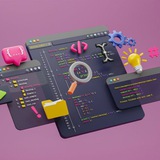✅ Learn New Skills FREE 🔰
1. Web Development ➝
◀️ https://t.iss.one/webdevcoursefree
2. CSS ➝
◀️ https://css-tricks.com
3. JavaScript ➝
◀️ https://t.iss.one/javascript_courses
4. React ➝
◀️ https://react-tutorial.app
5. Tailwind CSS ➝
◀️ https://scrimba.com
6. Data Science ➝
◀️ https://t.iss.one/datasciencefun
7. Python ➝
◀️ https://pythontutorial.net
8. SQL ➝
◀️ https://t.iss.one/sqlanalyst
9. Git and GitHub ➝
◀️ https://GitFluence.com
10. Blockchain ➝
◀️ https://t.iss.one/Bitcoin_Crypto_Web
11. Mongo DB ➝
◀️ https://mongodb.com
12. Node JS ➝
◀️ https://nodejsera.com
13. English Speaking ➝
◀️ https://t.iss.one/englishlearnerspro
14. C#➝
◀️https://learn.microsoft.com/en-us/training/paths/get-started-c-sharp-part-1/
15. Excel➝
◀️ https://t.iss.one/excel_analyst
16. Generative AI➝
◀️ https://t.iss.one/generativeai_gpt
Join @free4unow_backup for more free courses
Like for more ❤️
ENJOY LEARNING👍👍
1. Web Development ➝
◀️ https://t.iss.one/webdevcoursefree
2. CSS ➝
◀️ https://css-tricks.com
3. JavaScript ➝
◀️ https://t.iss.one/javascript_courses
4. React ➝
◀️ https://react-tutorial.app
5. Tailwind CSS ➝
◀️ https://scrimba.com
6. Data Science ➝
◀️ https://t.iss.one/datasciencefun
7. Python ➝
◀️ https://pythontutorial.net
8. SQL ➝
◀️ https://t.iss.one/sqlanalyst
9. Git and GitHub ➝
◀️ https://GitFluence.com
10. Blockchain ➝
◀️ https://t.iss.one/Bitcoin_Crypto_Web
11. Mongo DB ➝
◀️ https://mongodb.com
12. Node JS ➝
◀️ https://nodejsera.com
13. English Speaking ➝
◀️ https://t.iss.one/englishlearnerspro
14. C#➝
◀️https://learn.microsoft.com/en-us/training/paths/get-started-c-sharp-part-1/
15. Excel➝
◀️ https://t.iss.one/excel_analyst
16. Generative AI➝
◀️ https://t.iss.one/generativeai_gpt
Join @free4unow_backup for more free courses
Like for more ❤️
ENJOY LEARNING👍👍
👍6
Basics of Machine Learning 👇👇
Free Resources to learn Machine Learning: https://t.iss.one/free4unow_backup/587
Machine learning is a branch of artificial intelligence where computers learn from data to make decisions without explicit programming. There are three main types:
1. Supervised Learning: The algorithm is trained on a labeled dataset, learning to map input to output. For example, it can predict housing prices based on features like size and location.
2. Unsupervised Learning: The algorithm explores data patterns without explicit labels. Clustering is a common task, grouping similar data points. An example is customer segmentation for targeted marketing.
3. Reinforcement Learning: The algorithm learns by interacting with an environment. It receives feedback in the form of rewards or penalties, improving its actions over time. Gaming AI and robotic control are applications.
Key concepts include:
- Features and Labels: Features are input variables, and labels are the desired output. The model learns to map features to labels during training.
- Training and Testing: The model is trained on a subset of data and then tested on unseen data to evaluate its performance.
- Overfitting and Underfitting: Overfitting occurs when a model is too complex and fits the training data too closely, performing poorly on new data. Underfitting happens when the model is too simple and fails to capture the underlying patterns.
- Algorithms: Different algorithms suit various tasks. Common ones include linear regression for predicting numerical values, and decision trees for classification tasks.
In summary, machine learning involves training models on data to make predictions or decisions. Supervised learning uses labeled data, unsupervised learning finds patterns in unlabeled data, and reinforcement learning learns through interaction with an environment. Key considerations include features, labels, overfitting, underfitting, and choosing the right algorithm for the task.
Join @datasciencefun for more
ENJOY LEARNING 👍👍
Free Resources to learn Machine Learning: https://t.iss.one/free4unow_backup/587
Machine learning is a branch of artificial intelligence where computers learn from data to make decisions without explicit programming. There are three main types:
1. Supervised Learning: The algorithm is trained on a labeled dataset, learning to map input to output. For example, it can predict housing prices based on features like size and location.
2. Unsupervised Learning: The algorithm explores data patterns without explicit labels. Clustering is a common task, grouping similar data points. An example is customer segmentation for targeted marketing.
3. Reinforcement Learning: The algorithm learns by interacting with an environment. It receives feedback in the form of rewards or penalties, improving its actions over time. Gaming AI and robotic control are applications.
Key concepts include:
- Features and Labels: Features are input variables, and labels are the desired output. The model learns to map features to labels during training.
- Training and Testing: The model is trained on a subset of data and then tested on unseen data to evaluate its performance.
- Overfitting and Underfitting: Overfitting occurs when a model is too complex and fits the training data too closely, performing poorly on new data. Underfitting happens when the model is too simple and fails to capture the underlying patterns.
- Algorithms: Different algorithms suit various tasks. Common ones include linear regression for predicting numerical values, and decision trees for classification tasks.
In summary, machine learning involves training models on data to make predictions or decisions. Supervised learning uses labeled data, unsupervised learning finds patterns in unlabeled data, and reinforcement learning learns through interaction with an environment. Key considerations include features, labels, overfitting, underfitting, and choosing the right algorithm for the task.
Join @datasciencefun for more
ENJOY LEARNING 👍👍
👍6
Project ideas for Web Development 👆
💡 How many of these you have build already?
💡 How many of these you have build already?
👍6🔥4
